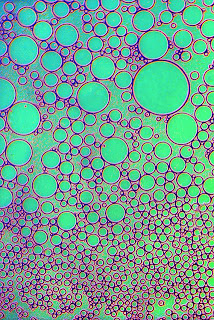This is a Hollandaise Sauce and it is best served on asparagus, egg benedict, and poach egg The picture below represent the emulsion under microscop. The big droplets represent oil droplets, the smaller one is the liquid droplets, and the smallest will be the lecithin that coats the droplets. |
The main ingredients for basic Hollandaise Sauce are :
- Egg yolk - it contains a natural emulsifying agent called lecithin. It will coat the fat droplets and one end of the molecule attracts water while the other end is drawn to fat. This process is called emulsion.
- Acid - it plays a very important role in stabilizing the emulsion of the oil and liquid. The acid causes the protein to repel each other, so that they break down/ unfold before bonding to each other and form an extended network rather than dense curds. This is why acid can help to prevent the sauce from curdling. Acid is also to improve the taste and tanginess of the sauce. Another important reason of using acid because it makes the environment acidic, thus it help to kill Salmonella in the sauce since we are using raw egg. The fun fact about acid is that when the acidity (low pH) of the sauce is closed to the acidity of yogurt, the yolk can be safely heated up to 90degree Celcius. WOW!
- Fat ( clarified or whole butter, warm ) - this is the medium for the emulsion to occur since emulsion only occurs when there is the presence of oil, water, and the third ingredient : imulsifier.
- Water - we used a little bit of water in the egg yolk before heating it slowly on the double boiler. This is because the water helps to prevent the heat from raising the egg yolk temperature increasing too fast that it may lead to scrambled egg.
- Salt - people always think that salt is just for seasoning. WRONG! I just learnt that salt also plays a very important role in the sauce making. The salt causes the yolk granules to fall apart into its component particles, which makes the yolks become both more clear and more viscous (thick). If left undiluted, this viscosity (thickness) will help break the oil into smaller droplets and smaller droplets mean thicker and creamier sauce.
- Pepper - this is for seasoning.
- Tabasco - for seasoning.
- Cayenne pepper - for seasoning.
Preparation and cooking process:
- Set up a double boiler using a sauce pan, filled with water about 1/3 and heat the water up to simmering stage ( 82-96 degree Celcius ).
- Crack open the egg and separate the egg white and the yolk. We will only use the egg yolk.
- Add a little bit of cold water into the egg yolk.
- Cover the pan with a cloth and mount ( is that a correct word ? ) the bowl onto the sauce pan (the cloth support the bowl so that it does not move around, so we can perform one man show- whisking while pouring the fat without no help ).
- Start whisking the egg yolk until it reaches the consistency that is desired. At this stage, the heat from the simmering water actually denatures and coagulates the protein in the egg yolk. Coagulation begins at 60 degree Celcius. The coagulation gives viscosity to the sauce. Timing and heat control is very important as too much heating will make the proteins coagulate into little solid curds and the sauce separates. This separation occurs at around 70 - 77 degree Celcius.
- Once it has reached the desirable consistency, start adding the warm whole butter in a thin stream line slowly. This is a very important stage because when we start adding the fat and whisk it, we already start the emulsion process. Do not add too much fat at one go, otherwise it will split. Emulsion simply means the ability to stabilize a system containing two immiscible liquids ( water and oil ). When we whisk the oil, we are actually breaking the oil into tiny droplets that can reach up to a ten-thousandth and a tenth of a millimeter across. The emulsifier in the egg yolk - lecithin, will quickly coat the droplets and attract the water droplets and bind them. In the early mixing, when little or no oil has yet been emulsified, it is easy for large droplets to avoud the churning action of the whisk and collect at the surface. If a large volume of oil is added before the previous one has been fully emulsified, then the bowl may end up with more unemulsified oil than water and result in an inside-out emulsion, oily and runny. This explains how splitting occurs.
- Keep adding the fat slowly until it reaches the consistency that is desired.
- Add the acid and seasoning for the last touch.
- Tabasco and cayenne pepper are used to improve the flavor too.
Please comment and if you notice any mistake, let me know and correct me. Thank you.


No comments:
Post a Comment